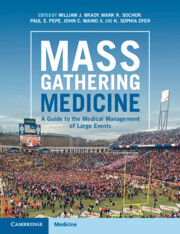Book contents
- Mass Gathering Medicine
- Mass Gathering Medicine
- Copyright page
- Dedication
- Contents
- Contributors
- Foreword
- Preface
- Chapter 1 An Introduction to Mass Gathering Medicine
- Chapter 2 Patient Care at Mass Gathering Events: Basic, Advanced, and Critical Care
- Chapter 3 Prediction of Medical Need and Event Risk Assessment at Mass Gathering Events
- Chapter 4 Medical Logistics and Operational Planning for Patient Care at Mass Gathering Events
- Chapter 5 Medical and Medical Support Staffing at Mass Gathering Events
- Chapter 6 Mass Gathering Medicine: Equipment and Planning Considerations
- Chapter 7 Incident Command System at Mass Gathering Events
- Chapter 8 Security and Other Nonmedical Logistical Support Issues at Mass Gathering Events
- Chapter 9 Understanding Local, State, and Federal Public Safety, Health Care, and Support Agencies
- Chapter 10 Common Themes and General Considerations across Mass Gathering Event Types
- Chapter 11 Mass Gathering Events: Youth, High School, Collegiate, Olympic, and Professional Sporting Events
- Chapter 12 Mass Gathering Events: Music Concerts and Festivals
- Chapter 13 Mass Gathering Events: Motor Sport Events
- Chapter 14 VIP and Executive Medicine Considerations at Mass Gathering Events
- Chapter 15 Mass Gathering Events: Community Events
- Chapter 16 Mass Gathering Events: Endurance Athletic Events
- Chapter 17 Mass Gathering Events: Extended Duration Events
- Chapter 18 At-Risk Populations within Mass Gathering Events
- Chapter 19 Crowd-Related Considerations at Mass Gathering Events: Management, Safety, and Dynamics
- Chapter 20 Civil Unrest and Terrorism Involving Mass Gathering Events
- Chapter 21 Impact of Weather and Climate Change on Mass Gathering Events
- Chapter 22 Occurrence of the Mass Casualty Incident at a Mass Gathering Event
- Chapter 23 Touring Medicine
- Chapter 24 Infectious Disease and Mass Gathering Medicine
- Chapter 25 Toxicology and Mass Gathering Medicine
- Chapter 26 Medicolegal Considerations in Mass Gathering Medicine
- Chapter 27 Business Considerations in Mass Gathering Medicine
- Index
- References
Chapter 18 - At-Risk Populations within Mass Gathering Events
Published online by Cambridge University Press: 11 April 2024
- Mass Gathering Medicine
- Mass Gathering Medicine
- Copyright page
- Dedication
- Contents
- Contributors
- Foreword
- Preface
- Chapter 1 An Introduction to Mass Gathering Medicine
- Chapter 2 Patient Care at Mass Gathering Events: Basic, Advanced, and Critical Care
- Chapter 3 Prediction of Medical Need and Event Risk Assessment at Mass Gathering Events
- Chapter 4 Medical Logistics and Operational Planning for Patient Care at Mass Gathering Events
- Chapter 5 Medical and Medical Support Staffing at Mass Gathering Events
- Chapter 6 Mass Gathering Medicine: Equipment and Planning Considerations
- Chapter 7 Incident Command System at Mass Gathering Events
- Chapter 8 Security and Other Nonmedical Logistical Support Issues at Mass Gathering Events
- Chapter 9 Understanding Local, State, and Federal Public Safety, Health Care, and Support Agencies
- Chapter 10 Common Themes and General Considerations across Mass Gathering Event Types
- Chapter 11 Mass Gathering Events: Youth, High School, Collegiate, Olympic, and Professional Sporting Events
- Chapter 12 Mass Gathering Events: Music Concerts and Festivals
- Chapter 13 Mass Gathering Events: Motor Sport Events
- Chapter 14 VIP and Executive Medicine Considerations at Mass Gathering Events
- Chapter 15 Mass Gathering Events: Community Events
- Chapter 16 Mass Gathering Events: Endurance Athletic Events
- Chapter 17 Mass Gathering Events: Extended Duration Events
- Chapter 18 At-Risk Populations within Mass Gathering Events
- Chapter 19 Crowd-Related Considerations at Mass Gathering Events: Management, Safety, and Dynamics
- Chapter 20 Civil Unrest and Terrorism Involving Mass Gathering Events
- Chapter 21 Impact of Weather and Climate Change on Mass Gathering Events
- Chapter 22 Occurrence of the Mass Casualty Incident at a Mass Gathering Event
- Chapter 23 Touring Medicine
- Chapter 24 Infectious Disease and Mass Gathering Medicine
- Chapter 25 Toxicology and Mass Gathering Medicine
- Chapter 26 Medicolegal Considerations in Mass Gathering Medicine
- Chapter 27 Business Considerations in Mass Gathering Medicine
- Index
- References
Summary
Mass gatherings create challenges to timely medical response. These challenges become amplified when medically and sociologically vulnerable individuals attend. Such at-risk persons may include, but certainly are not limited to, pregnant women, children, the elderly, people with chronic medical conditions, and those with one or more forms of disabilities. When planning for mass gatherings, or when directly managing large assemblies of persons that have evolved subsequent to mass evacuations of displaced persons retreating from a disaster, military conflict, or other humanitarian crisis, experience has shown that prospective preparedness and contingency planning addressing the needs of the entire community, including at-risk populations, facilitates better outcomes for all. Depending on the specific mass gathering, there will always be a variation in the unique concerns, event-driven nuances and potential at-risk populations in attendance for each. However, one recommended generic strategy to help provide a more unified and methodical approach to planning for at-risk persons is the Communication, Maintaining Health, Independence, Support and Safety and Transportation (CMIST) Framework. The CMIST framework has been shown to an extremely useful tool that can help event organizers and emergency managers better anticipate the various needs of these at-risk populations under a variety of mass gathering scenarios worldwide.
Keywords
- Type
- Chapter
- Information
- Mass Gathering MedicineA Guide to the Medical Management of Large Events, pp. 248 - 267Publisher: Cambridge University PressPrint publication year: 2024

